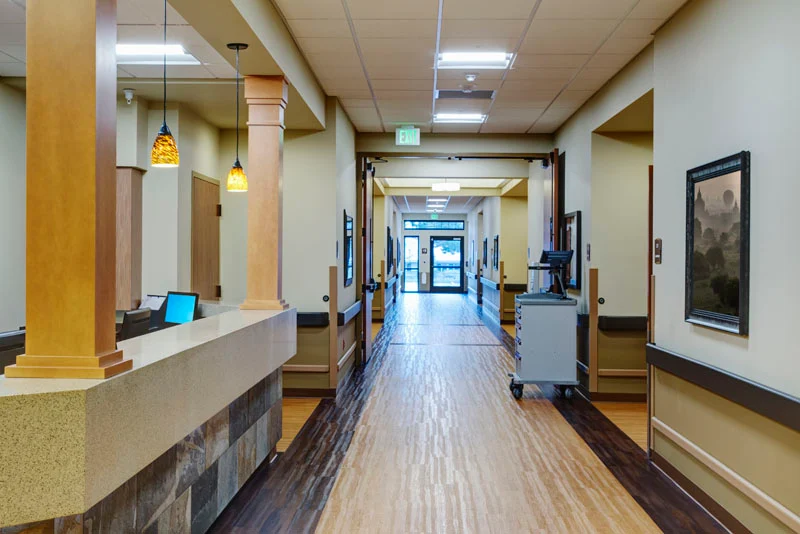As people become advanced in age many will experience changes to the way that their bodies can function. Loss of mobility, eyesight, or hearing are common age-related issues as are diminished capabilities due to arthritis or osteoporosis. While many seniors will battle these issues and others like them, at some point the issues can lead to a dangerous living environment when an older adult can no longer perform the tasks that they need to perform to care for themselves.
Once an aging person gets to the point when care that is needed in the home is more than what can be provided by the senior or caregivers, then it may well be time to consider moving the senior into an Assisted Living Facility (ALF). In this guide, we are going to explore what Assisted Living is, what it provides, and other essential information that you may need to make an informed decision regarding your choices for Assisted Living options.
Sections We Will Cover
This guide will touch on the following sections of information. Please feel free to click on any link below to go directly to that specific section:
- What to Look for in an Assisted Living Community
- Types of Services Assisted Living Offers
- How to Know When Assisted Living is Needed
- Difference Between Assisted Living and Nursing Home
- Typical Assisted Living Costs
- Who Can Live in Assisted Living?
- Does Medicare Pay for Assisted Living?
- How to Find Assisted Living
What to Look for in an Assisted Living Community
An assisted living facility offers a residential option for seniors who need help and guidance in performing daily tasks, such as preparing meals, getting out of bed, or traveling to doctor’s offices or supermarkets. Assisted living facilities are an attractive option for seniors who need help with non-clinical care services but don’t require medical supervision.
Based on the assisted living facility definition, the term “assisted” is emphasized, which means that a senior who is accepted in an assisted living home must be able to function independently on their own and must not be incapable of moving around the facility or be bedridden.
A senior assisted living facility will offer its residents 24-hour security and access to care. While the staff of assisted living facilities are not necessarily licensed medical professionals, access to medical and clinical staff for medical emergencies can be summoned quickly by the attending staff.
A good assisted living community will devise a personalized plan of services and care to accommodate the physical limitations of their residents without infringing on their privacy and freedom. For example, if a senior resident can perform daily living tasks but is having trouble driving, the assisted living facility may help to develop a transportation plan for this particular resident to make sure doctor’s visits can be attended regularly.
While there are plenty of newer Assisted Living Facilities, many senior communities have been built from already existing structures. For example, some Assisted Living Facilities have been converted from single-family homes into senior assisted group homes. There are older apartment complexes and abandoned buildings, such as schools and malls, that have been converted into assisted living communities, giving new life to an older building with a higher purpose.
Many assisted living facilities will offer residents luxury apartment-style living, but these accommodations tend to cost more. More moderately priced assisted living facilities may only provide residents with bedrooms and have a common dining room and living areas for recreational events and socialization.
Whatever financial circumstances you may have, there are assisted living facilities that will fit your budget. But keep in mind that budget is only one area to be concerned with. Selecting an Assisted living community that is located near loved ones will ensure that the senior is not isolated away from those who would regularly visit and provide care and support.
Types of Services Assisted Living Facilities Offer

Assisted living facilities must not be confused with nursing homes. Other common names used for assisted living are:
- Senior board and care
- congregate care
- senior residential care
- ALF
- Senior adult group home
- Senior adult care home
- Senior sheltered housing
- extra-care senior housing
- alternative senior care facility
While assisted living homes are non-clinical, residents can easily access medical personnel in case they need them. The typical services that an assisted living facility may offer include::
- Meal preparation (3 meals per day either served in an apartment-like setting or a common dining area)
- Assistance with ADL (eating, bathing and grooming, dressing up, mobility, and going to the bathroom)
- Housekeeping services
- Transportation to medical appointments, shopping malls, and other venues
- Access to medical and health facilities
- 24/7 security
- Emergency communication systems within the living spaces of each resident
- Physical fitness, exercise, and a wellness program that caters to the physical limitations of each resident
- Medication reminders (not disbursement)
- Engagement in social and recreational activities
- Laundry services
- Care staff will assist residents based on a fixed schedule. However, staff are also available for unplanned issues.
How to Know if Your or Your Loved Ones Need Assisted Living
If you are deciding whether an assisted living community could fit the needs of you or your loved ones, you need to ask the following questions:
Do you require more assistance than your family or friends can give you?
If you are constantly having difficulty with your activities of daily living and cannot have the assistance of family or friends at all times, then assisted living may be the right option for you.
Are you or your loved ones isolated and feeling lonely at home?
An active social life is important for your happiness and overall health. Being alone and having nobody to talk to much of the time can lead to feelings of depression. An assisted living home that offers a wide variety of social and recreational activities may be what you or your loved ones are missing.
Do you always worry about your safety?
If your mobility is limited because of age, you may worry about falling down and not being able to get up or not being able to climb stairs or get to vital items in your home. If this is the case, you should relocate to an assisted living home where staff and care aides regularly check up on you.
Do you have trouble maintaining your home?
You may be living in a large home by yourself after all your grown-up kids have gone away. It could be a struggle to maintain your old home, especially if it is too large to live in by yourself. If this is the case, you may sell or rent out your old home and use the money to stay in an assisted living facility where you do not have to worry about housekeeping and other home maintenance.
Assisted Living Facility vs Nursing Home

There are several long-term care options available for seniors. These options vary in terms of focus and level of care or medical services offered. Choosing the best option requires understanding the difference between an assisted living facility and a nursing home and knowing what each type of facility offers.
Assisted Living Facility
As the name implies, an assisted living facility offers a residential environment to seniors and veterans. In this type of facility, seniors are provided with non-medical yet trained staff to assist them in performing activities of daily living.
Skilled Nursing Home
Nursing homes (Skilled Nursing Facilities) are similar to Assisted Living Facilities in that they offer residential living to their patients. However, the level of care given to nursing homes is higher than assisted living and only Skilled Nursing Facilities provide medical treatment and oversight on an ongoing long-term basis.
Medical Services at an Assisted Living Facility
Residents in an assisted living home have fairly good health and do not necessarily require medical care. Residents of nursing homes, meanwhile, are elderly patients with chronic illnesses and require 24/7 monitoring by health and medical professionals. Nursing homes provide rehabilitative services to their residents to improve their body functions and mobility.
Living Space in An Assisted Living Community
Most Assisted living residents are provided with a private apartment with one bathroom. Nursing homes may offer private rooms with en-suite bathrooms at a higher cost but it is more typical to find shared rooms that have adjoining bathrooms, particularly if it is a Medicaid-accepted facility. Nursing homes tend to have common dining and living areas whereas residents in a senior assisted living facility may have restaurant-style dining areas. Assisted living homes may also offer more comfortable accommodations such as theaters cafes or recreational centers to allow residents to socialize with other residents.
Assistance with ADLs
Both nursing homes and assisted living centers assist their residents with ADLs. However, the assistance provided to nursing home residents is much higher and more frequent than those provided for assisted living residents.
Recreational Activities
Assisted living centers provide a wide range of activities to their residents to encourage socialization and overall well-being. Residents are provided with physical activities, religious services, and other opportunities to be more active in the community. For nursing homes, physical and recreational activities are more limited since their residents have more difficulty being mobile. Physical activities in a nursing home are often monitored or supervised by a physical therapist.
Meals
Assisted living residents typically have kitchens and may cook and prepare their meals any time that they want to. However, they can also usually choose to have their meals prepared by the dining room staff. On the other hand, nursing home residents do not have the freedom to prepare their meals. The meals are planned and provided for them by an in-house dietician and nutritionist.
Cost
In terms of cost, living in a nursing home is typically about twice as expensive as living in an assisted living facility. This cost is proportional to the high level of care a nursing home provides for its residents. The average national cost for living in a nursing home is $89k per year. Residents who choose to live in an assisted living home tend to pay approximately $48k per year.
Typical Assisted Living Facility Cost
When it comes to selecting an Assisted Living Community that fits your specific budget several factors influence the cost. We have listed those out for you below:
Size of Living Space
Assisted living communities have a wide variety of offerings that go anywhere from budget-friendly rooms to full luxury corner apartments. Very upscale assisted living communities may be composed of separate detached villas within a walled and well-landscaped gated community. The amount you have to pay will depend on the size of the living space you choose and the type of community that you select. You will pay more if you choose a whole apartment compared to a room with an en-suite bathroom. Keep in mind that many Assisted Living Facilities allow you to lower the cost by sharing the apartment with a roommate.
Types and Number of Services
The cost will also depend on the type and number of services that you will need. For example, suppose you can perform most of the activities of daily living and only need housekeeping services. In that case, you will pay less than a resident who needs assistance in several ADLs.
Location
Where you are located or would like to be located will also dictate the costs of staying in an assisted living community. It follows that if you live in an area with a high cost of living, the cost of living in an assisted home will also be high. If you are interested in an area that has a higher cost of living, but you are trying to maintain a smaller budget, try looking in areas just outside of the city center. These outlying rural areas tend to have a lower demand and thus go for a lower cost.
The cost of staying in an assisted living facility varies from state to state and will also vary within the state, depending on the quality of the facility. A 2018 Genworth Cost of Care Survey shows that the average national cost for assisted living is around $133 per day or $4,000 per month. If computed per year, the cost will be around $48,000 annually.
Who Can Live in an Assisted Living Facility?
Assisted living facilities are typically designed for seniors over the age of 55 with fairly good health and that require non-medical assistance with ADLs. However, some communities do not limit their residents to seniors alone. Some Assisted living facilities may accept non-seniors who have disabilities who need help with daily care but there is usually a limit to the number of units available within the communities that offer them.
Although doctors may recommend that a patient stay in an assisted living facility in order to be aided with their daily activities, patients that are accepted in assisted living facilities must not require the services of medical personnel. Patients who need constant medical services while transitioning from hospital confinement are better suited for skilled nursing facilities than assisted living.
If a senior is already a resident of an Assisted Living Community, the assisted living staff may help to arrange transportation for residents to get to their physical therapy sessions as long as the resident can still get safely around the assisted living community during that time.
Does Medicare Pay for Assisted Living?
A lot of people believe that Medicare will cover the costs of staying in an assisted living community. The truth is, that Medicare will not cover assisted living at all. Medicare does cover the costs of medical treatments and medicines while the patient is staying in an assisted living environment. More often than not, people who stay in assisted living communities cover the costs using their funds, funds from relatives, or by using their long-term health insurance coverage.
In some cases, Medicaid may pay for assisted living, but the program varies from state to state. Some states will require beneficiaries to spend their funds down to a certain point first before Medicaid starts paying for any assisted living services. In that case, the Assisted Living Facility that the family selects must be a Medicaid-certified facility.
It is important to note that if you choose to stay in an assisted living facility and plan to pay for the services through private funding then it would be best to select a facility that meets your needs as much as possible while still falling within your set budget.
How Can I Find Assisted Living Near Me?
While there are quite a few good search sites available, the absolute best tool to find assisted living near you is to look right here on Senioridy’s search platform. You can use our map-based search to locate an Assisted Living Facility near you or you can visit our listing page and filter out the facilities that best fit your needs. Remember, on Senioridy you can compare, save, and share your selections with those other decision-makers in your family so that everyone agrees on the selection that has been made. Then, just reach out directly to that assisted living facility by tapping the phone number or by sending them an inquiry. All calls and inquiries go straight to that assisted living facility with no cost to you for reaching out.

